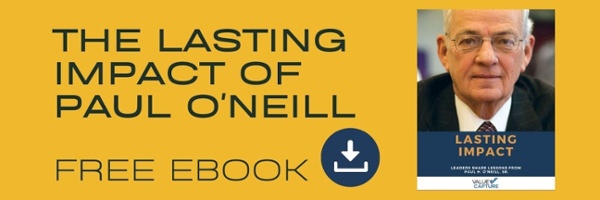Paul O’Neill, 84, a former U.S. Treasury secretary and Alcoa chief executive, died April 18, 2020, at his home in Pittsburgh, surrounded by family. He succumbed to his battle with cancer; his death is unrelated to the coronavirus.
Mr. O’Neill’s 13-year career at Pittsburgh-based Alcoa Corp. became the stuff of legends after he made zero workplace injuries a company mantra. Safety was part of a broader goal that Mr. O’Neill called “habitual excellence,” which later manifested into a passion for eliminating hospital-acquired infections.
In June 2019, Mr. O’Neill was honored for his service to the nation with the Gerald R. Ford Medal for Distinguished Public Service.
“Paul has devoted his life to service to the American people with his long-serving public service positions and dedication to making a difference,” Mike Ford, chairman of the Gerald R. Ford Presidential Foundation and son of the former president said at the time.
Mr. O’Neill was born Dec. 4,1935 in St. Louis, Mo., and served as Treasury secretary under President George H. W. Bush for 11 months until December 2002 when he was fired over policy differences. He was replaced by former CSX Corp. executive John Snow.
In his 2004 memoir, “The Price of Loyalty,” which was written by Pulitzer prize-winning journalist Ron Suskind, Mr. O’Neill said President Bush led cabinet meetings “like a blind man in a roomful of deaf people. There is no discernible connection.”
Mr. O’Neill received a bachelor’s degree in economics from California State University, Fresno and a master’s degree in public administration from Indiana University. He met his wife Nancy Jo at Anchorage High School, from which they both graduated in 1954.
Mr. O’Neill worked during the Johnson, Nixon and Ford administrations as a computer systems analyst and as deputy director of the Office of Management and Budget. He left the government to join International Paper in New York City in 1977, where he served as president from 1985 to 1987. He was chairman and CEO of Alcoa from 1987 to 1999 and retired as chairman at the end of 2000.
Alcoa’s market value increased to $27.53 billion in 2000 from $3 billion in 1986, while net income increased to $1.48 billion from $200 million during the same period.
During Mr. O’Neill’s 13-year tenure at Alcoa, the number of lost work days per 100 employees fell to 0.2 from 1.86. The statistics refers to days lost due to workplace injury or illness.
With Jewish Healthcare Foundation President and CEO Karen Wolk Feinstein, Mr. O’Neill co-founded the Pittsburgh Regional Healthcare Initiative as a way to press doctors and hospitals into ending infections that patients pick up in hospitals. Using Toyota’s team approach to manufacturing, the effort paid off handsomely.
In a 2006 study published in the Joint Commission Journal on Quality and Patient Safety, Mr. O’Neill and a hospital group led by physician Richard Shannon showed that a team-based approach to reducing bloodstream infections in an Allegheny General Hospital intensive care unit had lowered infections from 49 to six in a year and cut the number of deaths to one from 19.
Between 2003 and 2005, Dr. Shannon estimated that the AGH system had saved about $2.2 million in health care costs by reducing infections.
Through a leadership style that was energizing, exciting, “awe inspiring and sometimes intimidating,” Mr. O’Neill encouraged the people he worked with to collaborate in order to solve problems across many sectors and industries, said Ken Segel, who worked with Mr. O’Neill for 20 years.
Mr. Segel was the first director of the Pittsburgh Regional Healthcare Initiative and later worked with Mr. O’Neill to found Value Capture, a firm that provides support to CEOs of healthcare organizations dedicated to eliminating injuries and improving quality.
When they were starting out, Mr. Segel said Mr. O’Neill made a point to give everyone a seat at the table, from hospital representatives from 40 different companies to insurance providers to journalists to the state Attorney General.
“It was about taking away the excuses to being great together,” Mr. Segel said.
On one of many visits to hospitals and clinics with Mr. O’Neill, Mr. Segel recalled that he had a way of asking “child-like questions that just totally inspired new thinking.”
For example, he said, while speaking with a young doctor at a children’s hospital, the pair learned that the resident found it was difficult to take account for children’s lighter body weight when dosing insulin, putting the hospital at a greater risk for overdose. Mr. O’Neill asked how long it would take from when that insight entered the doctor’s brain to it being known by every other clinician doing that job in that hospital, across the city and across the entire profession.
“I think he inspired by example,” Mr. Segel said. “He wasn’t telling you the answers to anything, he was saying I think these are the principles that allow people and organizations to do great things.”
Mr. O’Neill helped launch the Pittsburgh Regional Healthcare Initiative when he was still chairman of Alcoa and he rejoined the group after leaving his job as President Bush’s Treasury secretary at the end of 2002.
“Paul was a friend, a dedicated public servant and a loyal Pittsburgher who leaves a remarkable legacy,” said former Pennsylvania governor Tom Ridge. The pair worked together when Mr. Ridge was governor to elevate academic standards in schools and later under President Bush when Mr. Ridge served as director of the Office of Homeland Security.
“My, how our nation could have benefited from a strategic and driven corporate leader and public servant like Paul O’Neill right now,” he said.
Janice Pringle, a professor in the University of Pittsburgh School of Pharmacy and a friend, colleague and coworker of Mr. O’Neill’s, said he had three sides: First, he was an innovative leader who places safety first in industry; second, he was a provocateur who tried to challenge the status quo; lastly, some people, including Ms. Pringle, will remember him for championing the ideal that people can achieve a vision of constantly working toward perfection.
He showed Ms. Pringle that “you can move toward optimal care for patients, you can transform your healthcare system into something that actually makes sure every person that enters it is not harmed and actually is made infinitely better.”
“He wasn’t an imposing man,” Ms. Pringle said. “He had a quiet voice, but he was sincere and it grabbed your attention … He always thought out of the box so you never quite knew what he would say.”
Ms. Pringle said the lesson that stuck with her the most was that Mr. O’Neill believed everybody intended to do a good job and provide meaning — and it was the role of a leader to recognize that meaning.
Mr. O’Neill served as a trustee of Pittsburgh-based health system UPMC from 2003 until September 2004. He was said to have clashed with CEO Jeffrey Romoff, but Mr. O’Neill said his main reason for leaving the board was UPMC’s refusal in early 2004 to join one of the healthcare initiative’s programs, which would’ve have committed hospitals to eliminating all medication errors.
The ill will between Mr. O’Neill and UPMC would fester until last year when he and former PNC Bank CEO Jim Rohr challenged UPMC trustees to individually express support for the the institution’s plan to restrict access to some UPMC hospitals and doctors for people with Highmark health insurance. UPMC and Highmark later reached an agreement that allowed some members to use UPMC facilities, depending on their Highmark coverage and making co-payments.
Mr. O’Neill also had an egalitarian streak and a touch for the common man. In his 2004 memoir, he wrote that a CEO should be judged by how be treats “whoever is at the very bottom.”
Not long after he took over at Alcoa, he pressed the Laurel Valley Golf Club near Ligonier to promote an open admissions policy, which would allow anybody — regardless of race or ethnicity to join — before he would allow Alcoa executives to remain as members. And in 2002, as Treasury secretary, Mr. O’Neill joined rock star Bono on a tour of Africa for an up close view of poverty.
“I doubt that I ever have known anyone who was more strongly committed to his principles or more deeply committed to Pittsburgh,” said Mark Nordenberg, chancellor emeritus of the University of Pittsburgh.
“He truly was a renaissance man,” said Robin Bernstein, who had known Mr. O’Neill for about 15 years and worked with him through the nonprofit organization Our Clubhouse. Mr. O’Neill and his wife Nancy helped get the charity off the ground, Ms. Bernstein said.
They were “exceedingly down-to-earth people in a way that you seldom find,” she said. “It's a loss for obviously his family, the city, the county, the country, he had a huge influence in so many areas.”
He disliked Alcoa’s imposing Downtown headquarters with “all these god-awful offices,” including the CEO suite at the end of a long hallway on the 30th floor. “So if you weren’t already intimidated, you would be by the time you got there,” he said in a 2014 Post-Gazette interview.
Alcoa later moved its headquarters to the North Shore, in a building that had an open office plan, and Mr. O’Neill’s office was in the middle of the floor. His office had the same 81 square feet of space as all the other offices.
A 2004 profile that appeared in the Guardian newspaper called him a “successful troublemaker.” In his memoir, Mr. O’Neill recalled something that a subordinate told him years earlier: “Paul, you have the [spine] of a daylight burglar.”
Despite Mr. O’Neill’s professional accomplishments, family was always his priority, said his son. Mr. O’Neill, who once mentioned in a U.S. Senate committee hearing that he was born into a house with no electricity or running water, had interests ranging from house projects to watercolor painting, said his son. “He and I probably spent 50 hours building a fence” at their home in Connecticut, said his son, while Mr. O’Neill was working at International Paper.
Mr. O’Neill died in the same Shadyside house that he and his family lived in since moving to Pittsburgh. “He thought he really did have a responsibility and really a duty to continue the legacy of what the big corporations had done in Pittsburgh,” said his son. “He fell in love with the city.”
He is survived by his wife of 65 years, Nancy, his son Paul Jr., of Sewickley, his daughter Patti, of Fairfax, Va., his daughter Margaret, of New Hampshire, his daughter Julie, of Sewickley, 12 grandchildren and 15 great-grandchildren. Funeral services will take place at a later date.
— Pittsburgh Post-Gazette





